Thanks for reading! If you haven’t already subscribed, please do. And thanks.


“I got ten calls. All of whom, young people, who otherwise would be excellent candidates to be able to put on ECMO. They’re so sick that if they don’t get… that support, they are probably going to die. I have three beds.” That’s what Dr. Jeffrey Dellavolpe of San Antonio Methodist Hospital in Texas told CNN this weekend, adding: “Making that decision… I don’t think a lot of us are prepared.”
Dellavolpe was talking about ECMO, or extracorporeal membrane oxygenation, an expensive and labor-intensive treatment that’s not right for everybody. But as his statement makes clear, in a state where the Lieutenant Governor Dan Patrick famously suggested that grandparents would be willing to die for the sake of the economy, when life-or-death decisions are being made, younger, healthier people are already being given priority.
On one hand, that makes sense for those who base their decisions on “actuarial tables.” On the other, given all we know about COVID-19, it’s a new way of rewarding bad behavior. As author Amanda Filipacchi wrote on Twitter, “it’s likely the young people were the ones partying, flouting the mask wearing.”


We can’t say we didn’t see this coming. We already had reports from Italy in March of medical professionals “weeping in the hospital hallways because of the choices they are going to have to make.”
The headline of the Boston Globe op-ed where that quote appeared reads: “A coronavirus cautionary tale from Italy: Don’t do what we did.”
Sarah Palin once said Death Panels would be “downright evil.” Trump made them a reality.
When Sarah Palin warned that Obamacare would create a future in which bureaucrats rationed America’s socialist healthcare—sitting on what she called “Death Panels”—Politifact called it the 2009 “Lie of the Year.”
In 2020, Trump Death Panels are a frightening new reality.
Especially for the disabled.
The issue is something Steven Spohn, the COO of AbleGamers, a 501(c)(3) charity that focuses on improving the lives of gamers with disabilities utilizing the power of videogames, has been documenting on Twitter.
In one viral thread, Spohn, who is himself disabled, posted the story of Michael Hickson, “a quadriplegic black man with COVID-19” who “was killed by a hospital in Austin Texas”:


Within the thread, Spohn posted the actual audio of a conversation between an unnamed doctor and Hickson’s wife Melissa, including this excerpt:
Doctor: So as of right now, his quality of life — he doesn’t have much of one.
Melissa: What do you mean? Because he’s paralyzed with a brain injury he doesn’t have quality of life?
Doctor: Correct.
Hickson was refused food or treatment for 6 days
“I happen to like my life,” tweeted Spohn, adding that what happened to Michael Hickson represents a dread shared by many in the disabled community: “We live our entire lives in fear that one day a doctor will decide we just aren't worth it.”
Spohn also tweeted:

Did it have to be this way? No.
As Dr. Howard P. Foreman wrote in USA Today on May 1:
Coronavirus is not just disproportionately affecting the old, it is also hitting communities of color, the disabled and those of limited means the hardest. And they are dying in vast numbers. We have a path forward that emphasizes testing, tracing and isolation: It minimizes harm, restarts our economy and puts people ahead of politics.
We saw it coming. We could have stopped it. As Foreman wrote, countries such as Germany, New Zealand, South Korea and Taiwan successfully crushed coronavius because they “emphasized aggressive testing, contact tracing and isolation/quarantine.”
In Foreman’s words:
None of this should be difficult for a nation that had a “Manhattan Project,” put a man on the moon and has laid claim to being the greatest on earth.
It’s now July. The US leads the world in coronavirus cases and deaths—with an estimated 20% of cases requiring hospitalization and 4.4% resulting in death. The US death rate is six times the world average.
Over the weekend it was reported that cases are increasing in 39 states, hospitalizations in 27 states, and deaths in 14 states.
Yet instead of putting a national testing strategy in place, Trump this weekend insisted, ridiculously, that 99% of America’s coronavirus cases are “totally harmless.”
A “scorecard” to determine who lives and dies.
In Arizona, where in May protesters lay body bags outside the state Capitol to warn the Republican Governor he was reopening “too soon, too fast,” the state is now using scorecards to tell hospitals how to triage patients, deciding who gets access to lifesaving treatments based on factors like their age, pre-existing conditions, and likelihood of recovery.


So while Trump is “liberating” states and reassuring the currently healthy that the coronavirus is “totally harmless,” and while college students and young partygoers may still find a bed in the ICU, others, no matter how responsible they have tried to be during the pandemic, may face a different reality: a scorecard that tells them to get to the back of the line, because the state now deems their life the “lowest priority.”
Thanks for reading and sharing! Through election day, all content will be free, so if you haven’t already subscribed, please do. Free or paid, you’ll get every ad-free issue by email:
If you’d like to support with a one-time donation, I’ve added a “buy me a coffee” option, too. Thanks!


